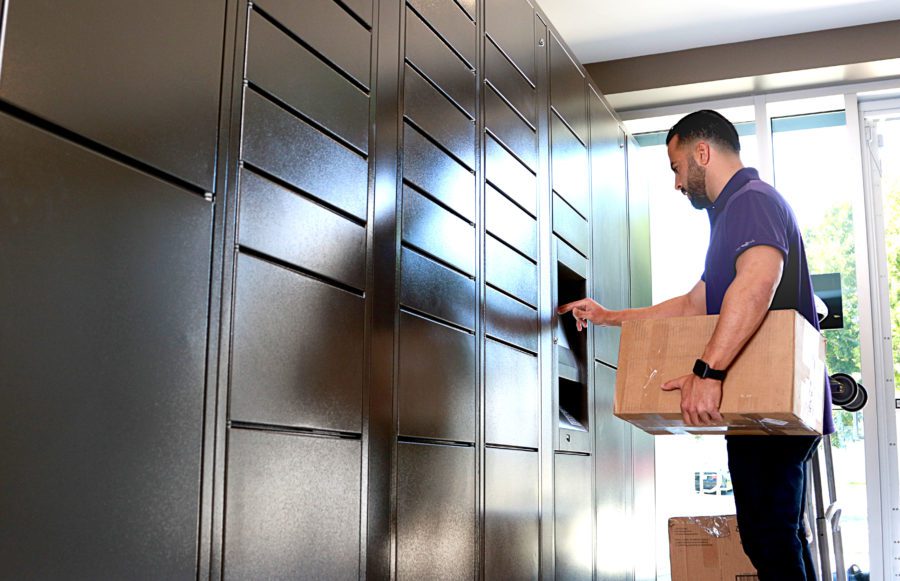
Commercial
12 Office Security Strategies to Maximize Workplace Safety
Written by: Parcel Pending
4 Min Read
Published: December 7, 2023
Updated: December 20, 2023
The primary purpose of a workplace safety program is to prevent workplace injuries, illness, or death. Of course, an equally important purpose is to protect the company and its reputation, as well as mitigate risk.
This article will cover the importance of workplace safety and office security systems, and share 12 strategies to consider implementing to maximize safety in the workplace for your tenants and/or employees.
Importance of Workplace Safety
Employees deserve a safe place to work. Federal agencies such as OSHA (Occupational Safety and Health Administration) mandate that all workplaces are free of known health and safety hazards. Local and state workplace security laws also come into play.
As such, it’s a company’s moral and legal obligation to protect its employees. By implementing physical security measures and office security systems to make your office a safe place to work, your employees will feel more secure and, therefore, be more productive, and potential customers may even view your company’s brand more positively.
The Benefits of a Safe Workplace
Workplace security and safety strategies are a win/win: they benefit both employers and employees for the following reasons:
- Solid Brand Reputation – An employer known for ensuring safety in the workplace and taking care of its employees earns high points on the brand reputation scale.
- Higher Morale – Workplace security solutions, safety policies, and and workplace security programs make workers feel more engaged with and positive about their employer.
- Lower Absenteeism – Safe employees feel good about coming to work, as they know they are protected. Further, fewer accidents and security risks translate into fewer missed days of work.
- Reduced Insurance Premiums – A safe workplace with few safety and security risks/incidents quickly translates into lower premiums.
- Adherence to Local, State, and Federal Laws – A strong safety culture leads to higher compliance and fewer interactions with regulatory agencies.
- Higher Productivity – Workers who know that their employer is committed to safety feel less stressed and, as a result, tend to be more productive.
- Better Recruiting Rates – Happy employees can entice other candidates to join the company based on the maxim that good begets better.
12 Strategies to Boost Workplace Safety
#1 Implement a Dress Code
Whether you work at an office or a factory, distinguishing between acceptable and unacceptable attire is essential. Some companies require closed-toe shoes, whereas other offices retain a strict dress code that reduces the chance of harassment. A formal dress code policy also eliminates the grey areas and questions about what is appropriate to wear.
#2 Reduce Office Clutter
Piled papers and storage boxes in the aisles or walkways increase the chances of a trip and fall accident. Besides adhering to aesthetic corporate office design trends, tidy desks and clean work surfaces also promote a focused environment that reduces sensitive information leaks.
#3 Keep Common Areas Clean
Dirty coffee cups are a frequent complaint in offices. Office organization ideas like assigning one worker weekly for kitchen duty ensures that dishes and trash aren’t polluting the workspace.
#4 Review Reporting Procedures
Employees must know how and when to report an unsafe situation. Besides introducing the protocols at new hire orientation, be sure to periodically review security solutions and procedures (e.g., access control and other best practices) throughout the year with electronic reminders. Instituting assessments, digital checklists, as well as regular walkthrough, and evaluations of your workplace’s physical security system alert employees that safety is critical.
#5 Practice Emergency Procedures
Employees must know emergency exit procedures and fire drill gathering points, as well as what to do in an emergency and who to call. Develop regular training times to review these protocols and ensure your employees are in the know.
#6 Wear Safety Gear
Safety gear requirements must be followed from construction sites to factories. Hard hats, steel-toe shoes, safety goggles, and orange vests work to keep employees safe.
#7 Lift Objects Carefully
According to the Bureau of Labor Statistics (BLS), more than one million workers suffer back injuries each year, and back injuries account for one of every five workplace injuries or illnesses.1 The primary cause? Incorrect lifting of objects. Reiterate with employees how to lift correctly and when to ask for assistance.
#8 Promote Employee Hygiene
Although social distancing rules are now over, health and safety remain top of mind. Staying home when sick is now de rigueur. Coughing into one’s elbow is also a reemerging habit in this post-pandemic environment. Of course, hand sanitizers throughout the workspace also decrease the spread of germs.
#9 Encourage Breaks
Research supports that taking breaks increases energy, productivity, and focus among employees.2 A focused employee is also more likely notice unsafe conditions.
#10 Close Doors and Drawers
A simple way to reduce accidents and injuries is by instilling the habit of closing doors and cabinets. A closed door or drawer promotes access control measures, protects sensitive information, and ultimately creates a safer space – whether it’s the office drawer, supply cabinet, or kitchen cupboard.
#11 Avoid Unfamiliar Equipment
Untrained employees mustn’t attempt to operate machinery for which they are not fully trained. Restricting accessonly to specific, qualified employees helps prevent accidents.
#12 Install Smart Lockers
With the permanence of a hybrid work schedule, there’s a need for safely and securely transferring documents, badges, laptops, and other physical resources between employees. Implementing an innovative office technology solution such as Parcel Pending by Quadient’s Corporate Campus Hub™, for instance, allows employees to leverage smart electronic lockers to safely store and retrieve items within 10 seconds using a unique six-digit access code or by scanning a unique barcode from their mobile device.
Ready to add modern office lockers to your office safety and security measures? Speak to one of our package management experts today.
Sources:
- University of Maryland Department of Environmental Safety, Sustainability, and Risk. Back Injuries Fact Sheet. essr.umd.edu. January 3, 2022. https://essr.umd.edu/about/occupational-safety-health/ergonomics/back-injuries-fact-sheet
- Cornell Health. Study Breaks & Stress-Busters. health.cornell.edu. November 19, 2020. https://health.cornell.edu/about/news/study-breaks-stress-busters



